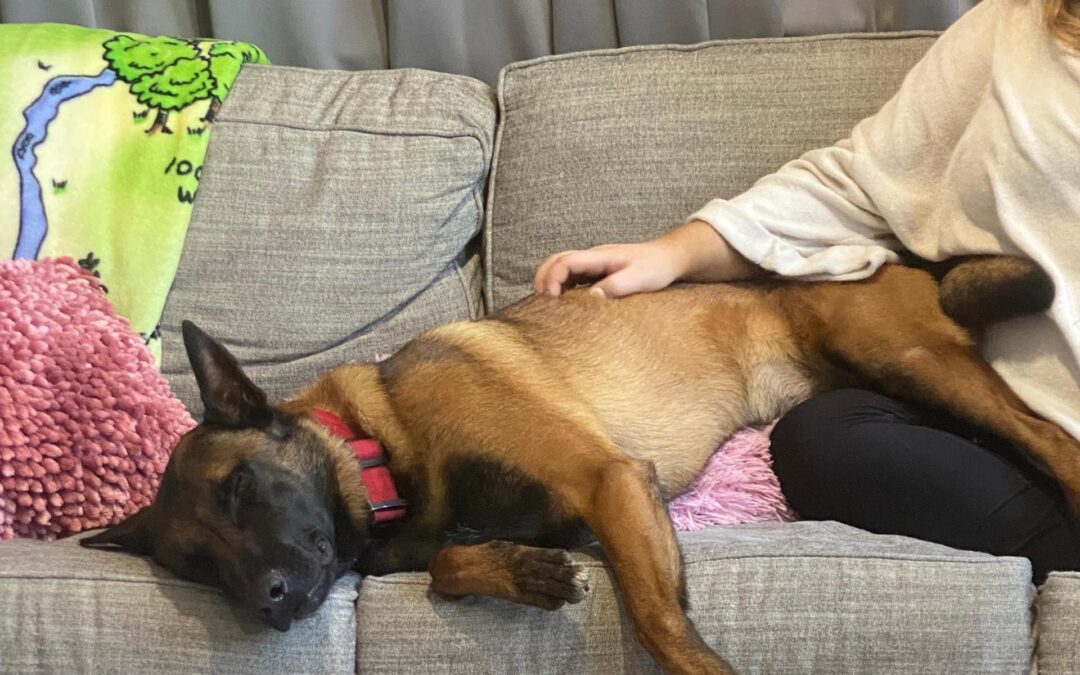When people think of a therapy dog, the most common image tends to be a cute and gentle golden retriever quietly si:ng by someone’s feet and slowly wagging its tail. But what if that therapy dog is a muscular pit bull? A confident Doberman? A stoic Belgian Malinois? For a lot of people, the first reaction is a hesitation, a question of “What’s that dog doing in here?” Yet, over and over again, these dogs prove that empathy and understanding come in all shapes and sizes.
Reassess “Scary”
My favorite story to tell about my Belgian Malinois therapy dog, Zero, involves a 6-year-old boy. When he saw Zero for the first time, he froze – a clear “WHOA” on his face. But Zero slowly walked up to him, lay down, and waited. It took two seconds for the boy to reach out his hand, Zero to lick it, and the tension to disappear. That’s connection. It’s the moment in any relationship, therapeutic or otherwise, that reminds us that it’s okay to just be ourselves in the space in the moment, and a reminder that things are not always as they seem.
Historically, certain breeds have been categorized as dangerous or unpredictable. Media coverage, myths, and local laws fuel these ideas – think about the pit bull ban in the UK. However, when you really look at it, “scary” dogs are most often loyal, eager to please, and deeply aUuned to the humans in their life. And this is what can make them phenomenal therapy dogs.
It’s Not About Breed – It’s About Behavior
The making of an ideal therapy dog isn’t the breed, it’s the temperament. Every golden retriever isn’t going to make the cut, just like not every Malinois will. Emotional stability, playfulness, desire to connect with humans, and desire to work are some traits that make a great therapy dog. These traits can be found in any dog – they’re not breed-specific.
Training and temperament assessments are critical for every therapy dog regardless of appearance. For most therapy dog cer:fica:ons, the dog must undergo serious testing in order to earn the title. For the type of work Zero and I do, Animal Assisted Play Therapy ®, we also had to complete several different measures, observations, and I had to undergo tons of training. Honestly, Zero’s breed is what made him pass those with flying colors. He – like most “scary” breeds – is incredibly intuitive and people-focused, and this shows in his work.
How We Heal
Working with a misunderstood dog can be therapeutic inside and outside of the therapy room. How many times have you felt misunderstood? Zero, too. How many times have you felt let out? Zero, too. How many times has the world told you that you’re too much? Zero, too.
It’s a wonderful moment when a client realizes that healing can come from an animal that society has labeled “too much.” It’s powerful to know that these types of experiences are shared by most everyone and everything, and it creates an opportunity for clients to talk about their own experiences and how they’ve shaped thoughts, feelings, and behaviors.
The Balance of Safety and Perception
Of course, safety always comes first. As discussed above, any dog that earns the title of “Therapy Dog” has to undergo temperament testing, training, and supervision. It’s also my responsibility as the handler/therapist to share information about Zero’s breed and how that relates to him as an individual. I also provide lots of education on the way Zero and other dogs communicate and we practice ways to communicate with Zero prior to him being in session. Sharing information and education and giving people space to express their comfort level, or discomfort level, is a sign of respect and professionalism, and is incredibly important in this work.
Most of the time, a client’s hesitation isn’t personal – it’s molded by culture and experience, and there’s power and importance in that. Some:mes, a client will set a boundary for themselves that they don’t want to work with Zero, maybe for a session or maybe for forever, and that work is just as powerful as directly working with him. It can be hard to say no!
“Scary” dogs aren’t often all that scary when you meet them heart-first. Speaking for Zero, he’s smart, sensitive, and resilient – just like my clients. By looking beyond the label of what a Malinois can be, we can see who Zero is, and that’s where the connection and healing starts.
Have you worked with a “scary” breed before or met one that made you change your mind about that title? Share your experience! Let’s rewrite these dogs’ stories – one tail wag at a me!






